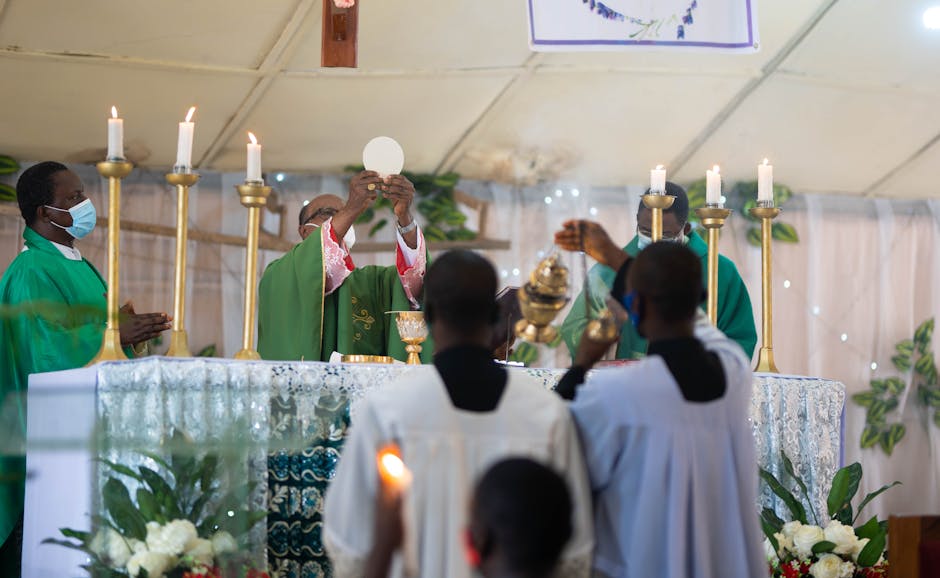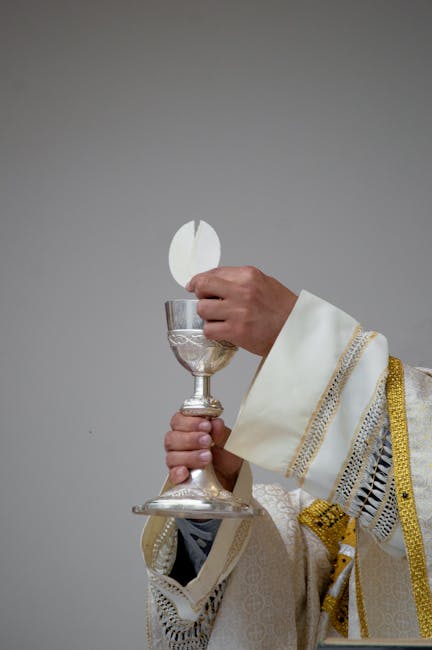In the battle of beliefs regarding the Eucharist, scholars and theologians alike have been debating for centuries: is the communion wafer truly the body of Christ, or just a symbolic representation? Like choosing between cake or fruit for dessert, the debate rages on as we dig into the delicious details of Eucharistic theologies. So grab a seat at the table and let’s feast on the feast that’s causing all the fuss.
Understanding the Eucharist in Catholic Theology
Breaking Bread or Transforming Bread?
When it comes to the Eucharist in Catholic theology, there’s an age-old debate that has divided scholars for centuries. Some argue that the bread and wine used in the sacrament are merely symbolic representations of Christ’s body and blood. Others, however, believe that through the process of transubstantiation, the bread and wine actually become the literal body and blood of Christ. It’s like the ultimate foodie magic trick – turning carbs and booze into the flesh and blood of our Lord and Savior.
Chew on This: The Real Presence
Catholics believe in what is known as the Real Presence of Christ in the Eucharist. This means that when they receive communion, they are not just chomping down on some stale bread and watered-down wine. No, they are literally ingesting the body and blood of Christ. It’s like a holy version of those gummy vitamins – good for the soul and the digestive system.
The Sacrifice of the Mass
In Catholic theology, the Eucharist is seen as a re-presentation of Christ’s sacrifice on the cross. When the priest consecrates the bread and wine during Mass, it is believed that he is reenacting the Last Supper and offering the same sacrifice that Christ made for the redemption of mankind. So next time you’re at church and your stomach starts growling during the consecration, just remember – it’s not brunch, it’s a sacred ritual.
Historical Development of Eucharistic Theologies
Throughout history, Eucharistic theologies have evolved and taken on different interpretations. From the early church fathers to the medieval theologians, there have been a variety of beliefs surrounding the significance of the Eucharist.
One popular view held by some theologians is the Real Presence of Christ in the Eucharist. This belief holds that when the bread and wine are consecrated during the Eucharistic celebration, they actually become the body and blood of Christ. **Talk about a transformation!** This belief has led to much debate and controversy throughout the centuries.
On the other hand, some theologians hold to a symbolic view of the Eucharist. They believe that the bread and wine merely represent the body and blood of Christ, and do not actually change in substance. **It’s like a divine game of make-believe!** This view has also sparked heated discussions and disagreements among Christians.
As time has passed, different denominations within Christianity have developed their own unique Eucharistic theologies. From transubstantiation in the Catholic Church to memorialism in some Protestant denominations, there is no shortage of opinions on what actually happens during the Eucharistic celebration. **It’s a theological smorgasbord!**

Theological Debate: Real Presence vs. Symbolic Representation
When it comes to the debate over the Real Presence versus Symbolic Representation in the Eucharist, you might as well be stepping into a theological boxing ring. The two sides are ready to duke it out, armed with Scripture, tradition, and a healthy dose of passion.
On one side, you have the Real Presence camp, who believe that when the priest consecrates the bread and wine, they truly become the body and blood of Christ. It’s not just a symbol, folks. It’s the real deal - body, blood, soul, and divinity.
But hold on a minute! The Symbolic Representation crew isn’t backing down without a fight. They argue that the bread and wine are just symbols of Christ’s body and blood, meant to help us remember the sacrifice He made for us. It’s all about symbolism, baby!
As the theological gloves come off and the arguments start flying, one thing is for sure: this debate isn’t going away anytime soon. So grab your popcorn, sit back, and enjoy the show.

Scriptural Foundation for Eucharistic Theologies
When it comes to Eucharistic theologies, the scriptures are our trusty guide through all the debates and discussions. Here are some key passages that have sparked a lot of lively interpretations:
- John 6:51-58 - Jesus really doubles down on the whole “eat my flesh, drink my blood” thing here. No wonder it’s caused so much confusion over the centuries!
- 1 Corinthians 11:23-26 – Paul lays down the law on how to properly partake in the Lord’s Supper. Spoiler alert: it’s not just about scarfing down bread and wine.
These passages have been dissected, analyzed, and reinterpreted more times than we can count. Some see them as straightforward instructions on how to partake in the Eucharist, while others see hidden meanings and symbolic gestures woven throughout. It’s a theological minefield out there!
But fear not, dear reader, for amidst all the scholarly squabbles and theological tussles, one thing remains clear: the Eucharist is a central tenet of Christian faith and should be approached with reverence and humility. Whether you believe in transubstantiation, consubstantiation, or “it’s all a metaphor, dude,” let’s all agree to break bread together in the spirit of love and unity.

Interpretation of Eucharistic Symbols in Different Christian Traditions
Have you ever wondered why some Christian traditions use unleavened bread for Communion while others use leavened bread? Well, let me break it down for you in the most hilarious way possible!
In the Eastern Orthodox tradition, leavened bread is used to symbolize the Risen Christ. The rising of the bread represents Jesus conquering death and emerging victorious from the tomb. It’s like a fluffy, delicious reminder that Jesus is alive and kickin’!
On the other hand, in the Roman Catholic tradition, unleavened bread is used to symbolize the sinlessness of Christ. Just like this bread is free from yeast, Jesus was free from sin. So when you munch on that flat, cracker-like piece of bread, you’re basically celebrating the fact that Jesus was the ultimate goody two-shoes.
And let’s not forget about the wine! In some traditions, red wine is used during Communion to symbolize the blood of Christ shed for our sins. But in others, grape juice is used because, well, they don’t want the kids getting drunk on Jesus juice!
FAQs
What exactly is Eucharistic theology?
Eucharistic theology is like the Food Network for the soul. It’s all about trying to figure out what happens when we chow down on that blessed bread and wine during communion.
What are the two main perspectives on Eucharistic theology?
Well, it’s kind of like the ultimate showdown between Team Presence and Team Symbol. Team Presence believes that Jesus is physically present in the bread and wine, while Team Symbol thinks it’s all just a metaphorical representation.
How do theologians argue for the real presence of Jesus in the Eucharist?
Some theologians get all sciency and reference things like transubstantiation or consubstantiation to explain how the bread and wine actually become the body and blood of Christ. It’s like Jesus performing a magic trick right in front of our very eyes!
What are some arguments for the symbolic view of the Eucharist?
Those on Team Symbol like to keep things simple and believe that the bread and wine are just symbolic reminders of Jesus’ sacrifice on the cross. It’s kind of like a spiritual Post-it note, reminding us to be grateful for all that Jesus did for us.
Are there any theologians who try to find a middle ground between presence and symbol?
Oh, you betcha! Some theologians like to think outside the box and suggest that maybe there’s a little bit of both presence and symbol going on during communion. It’s like having your cake and eating it too (or in this case, having your bread and eating it too!).
Why is it important to understand Eucharistic theology?
Well, for starters, communion is kind of a big deal in Christianity, so it’s important to have a good grasp on what exactly is happening when we partake in the Eucharist. Plus, being able to debate presence versus symbol at your next church potluck will definitely earn you some theological street cred!
—
In Conclusion: Holy Moly, It’s the Eucharist!
Well, there you have it folks – a delectable deep dive into the world of Eucharistic theologies. As we’ve discovered, the age-old debate between presence and symbol is as juicy as a perfectly baked communion wafer.
Whether you believe in the mystical transformation of bread and wine into the body and blood of Christ, or simply see them as poignant reminders of Jesus’ sacrifice, one thing’s for certain – the Eucharist sure knows how to stir up some spirited conversation.
So next time you’re at mass, take a moment to savor that sacred meal and ponder the theological feast laid out before you. And remember, whether you’re firmly in Camp Presence or Team Symbol, we can all come together in our love for a good old fashioned theological food fight. Amen, and pass the wine!






